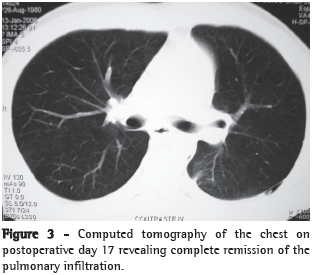Negative-pressure pulmonary edema accompanied by hemorrhage as a manifestation of upper airway obstruction is an uncommon problem that is potentially life-threatening. The principal pathophysiological mechanism involved is the generation of markedly negative intrathoracic pressure, which leads to an increase in pulmonary vascular volume and pulmonary capillary transmural pressure, creating a risk of disruption of the alveolar-capillary membrane. We report the case of an adult male with diffuse alveolar hemorrhage following acute upper airway obstruction caused by the formation of a cervical and mediastinal abscess resulting from the insertion of a metallic tracheal stent. The patient was treated through drainage of the abscess, antibiotic therapy, and positive pressure mechanical ventilation. This article emphasizes the importance of including this entity in the differential diagnosis of acute lung injury after procedures involving upper airway instrumentation.
Hemorrhage; Pulmonary edema; Airway obstruction; Abscess; Prostheses and implants



